Impacts of Olive Waste-Derived Biochar on Hydro-Physical Properties of Sandy Soil
Abstract
1. Introduction
2. Materials and Methods
2.1. Collecting and Preparing the Soil Sample
2.2. Collecting Olive Waste and Producing Biochar
2.3. Soil and Biochar Analyses
2.4. Carbon, Hydrogen, and Nitrogen (CHN) and Surface Area Analyses of Biochar
2.5. Column Experiment Setup
2.6. Cumulative Evaporation
2.7. Wetting and Evaporation Cycles
2.8. Soil Moisture Distribution
2.9. Soil Water Retention
2.10. Hydraulic Conductivity
2.11. Infiltration Measurements
2.12. Experimental Design
2.13. Statistical Analyses
3. Results and Discussion
3.1. Biochar Chemical Properties
3.2. Effect of Soil Supplements on Soil Physical Properties
3.2.1. Wetting, Evaporation Cycles, and Cumulative Evaporation
3.2.2. Saturated Hydraulic Conductivity
3.2.3. Infiltration
3.2.4. Water Retention
4. Conclusions
Author Contributions
Funding
Data Availability Statement
Acknowledgments
Conflicts of Interest
References
- Aly, A.A.; Al-Omran, A.M.; Sallam, A.S.; Al-Wabel, M.I.; Al-Shayaa, M.S. Vegetation cover change detection and assessment in arid environment using multi-temporal remote sensing images and ecosystem management approach. Solid Earth 2016, 7, 713–725. [Google Scholar] [CrossRef]
- Aly, A.A.; Al-Omran, A.M.; Khasha, A.A. Water management for cucumber: Greenhouse experiment in Saudi Arabia and modeling study using SALTMED model. J. Soil Water Conserv. 2015, 70, 1–11. [Google Scholar] [CrossRef]
- Al-Barakah, F.N.; Aly, A.A.; Abaakhel, E.H.S.; Al-Rizki, A.M.; Alghamdi, A.G.; Al-Sewailem, M.S. Comparison and hydrochemical characterization of groundwater resources in the Arabian Peninsula: A case study of Al-Baha and Al-Qassim in Saudi Arabia. Water Resour. 2020, 47, 877–891. [Google Scholar] [CrossRef]
- Alghamdi, A.G.; Aly, A.A.; Al-Omran, A.M.; Alkhasha, A. Impact of biochar, bentonite and compost on physical and chemical characteristics of a sandy soil. Arab. J. Geosci. 2018, 11, 670–678. [Google Scholar] [CrossRef]
- Alghamdi, A.G. Biochar as a potential soil additive for improving soil physical properties—A review. Arab. J. Geosci. 2018, 11, 766. [Google Scholar] [CrossRef]
- Alkhasha, A.; Al-Omran, A.; Aly, A. Effect of biochar and synthetic polymer on hydro-physical properties of sandy soils. Sustainability 2018, 10, 4642. [Google Scholar] [CrossRef]
- Ibrahim, A.; Usman, A.R.A.; Al-Wabel, M.I.; Nadeem, M.; Ok, Y.S.; Al-Omran, A. Effects of Conocarpus biochar on hydraulic properties of calcareous sandy soil: Influence of particle size and application depth. Arch. Agron. Soil Sci. 2017, 63, 185–197. [Google Scholar] [CrossRef]
- Ibrahim, H.M.; Al-Wabel, M.I.; Usman, A.R.A.; Al-Omran, A. Effect of Conocarpus biochar application on the hydraulic properties of a sandy loam soil. Soil Sci. 2013, 178, 165–173. [Google Scholar] [CrossRef]
- Al-Omran, A.; Ibrahim, A.; Alharbi, A. Evaluating the impact of combined application of biochar and compost on hydro-physical properties of loamy sand soil. Commun. Soil Sci. Plant Anal. 2019, 50, 2442–2456. [Google Scholar] [CrossRef]
- Igalavithana, A.; Ok, Y.; Niazi, N.; Rizwan, M.; Al-Wabel, M.; Usman, A.; Moon, D.; Lee, S. Effect of corn residue biochar on the hydraulic properties of sandy loam soil. Sustainability 2016, 9, 266. [Google Scholar] [CrossRef]
- Randolph, P.; Bansode, R.R.; Hassan, O.A.; Rehrah, D.J.; Ravella, R.; Reddy, M.R.; Ahmedna, M. Effect of biochars produced from solid organic municipal waste on soil quality parameters. J. Environ. Manag. 2017, 192, 271–280. [Google Scholar] [CrossRef]
- Ulyett, J.; Sakrabani, R.; Kibblewhite, M.; Hann, M. Impact of biochar addition on water retention, nitrification and carbon dioxide evolution from two sandy loam soils. Eur. J. Soil Sci. 2014, 65, 96–104. [Google Scholar] [CrossRef]
- Głąb, T.; Palmowska, J.; Zaleski, T.; Gondek, K. Effect of biochar application on soil hydrological properties and physical quality of sandy soil. Geoderma 2016, 281, 11–20. [Google Scholar] [CrossRef]
- Mangrich, A.; Cardoso, E.; Doumer, M.; Romão, L.; Vidal, M.; Rigol, A.; Novotny, E. Improving the water holding capacity of soils of northeast brazil by biochar augmentation. Chapter in ACS Symposium Series. Am. Chem. Soc. 2015, 1206, 339–354. [Google Scholar]
- El-Bassi, L.; Azzaz, A.A.; Jellali, S.; Akrout, H.; Marks, E.A.N.; Ghimbeu, C.M.; Jeguirim, M. Application of olive mill waste-based biochars in agriculture: Impact on soil properties, enzymatic activities and tomato growth. Sci. Total Environ. 2021, 755, 142531. [Google Scholar] [CrossRef] [PubMed]
- Marks, E.A.; Kinigopoulou, V.; Akrout, H.; Azzaz, A.A.; Doulgeris, C.; Jellali, S.; Jeguirim, M. Potential for production of biochar-based fertilizers from olive mill waste in Mediterranean Basin countries: An initial assessment for Spain, Tunisia, and Greece. Sustainability 2020, 12, 6081. [Google Scholar] [CrossRef]
- Hillel, D. Soil and Water Physical Principles and Processes; Academic Press: New York, NY, USA, 1971. [Google Scholar]
- Walkley, A.; Black, I.A. An examination of the Degtjareff method for determining soil organic matter and a proposed modification of the chromic acid titration method. Soil Sci. 1934, 37, 29–38. [Google Scholar] [CrossRef]
- Gee, G.W.; Bauder, J.W. Particle-size analysis. In Methods of Soil Analysis, Part 1. Physical and Mineralogical Methods, Agronomy Monograph No. 9, 2nd ed.; Klute, A., Ed.; Soil Science Society of America: Madison, WI, USA, 1986; pp. 383–411. [Google Scholar]
- Sparks, D.L. Methods of Soil Analysis, Part 3. Chemical Methods; SSSA Book Series No. 5; Soil Science Society of America: Madison, WI, USA, 1996. [Google Scholar]
- ASTM. Standard Methods for Chemical Analysis of Wood Charcoal; ASTM D1762-84; ASTM: Philadelphia, PA, USA, 1989. [Google Scholar]
- Richards, L.A. Porous plate apparatus for measuring moisture relation and transmutation. Soil Sci. 1948, 66, 105–110. [Google Scholar] [CrossRef]
- Zhang, R. infiltration models for the disc infiltrometer. Soil Sci. Soc. Am. J. 1997, 61, 1597–1603. [Google Scholar] [CrossRef]
- Philip, J.R. The theory of infiltration: 1. The infiltration equation and its solution. Soil Sci. 1957, 83, 345–358. [Google Scholar] [CrossRef]
- Snedecor, G.W.; Cochran, W.G. Statistical Method, 7th ed.; The Iowa State University Press: Iowa, IA, USA, 1980; p. 476. [Google Scholar]
- Tomczyk, A.; Sokołowska, Z.; Boguta, P. Biochar physicochemical properties: Pyrolysis temperature and feedstock kind effects. Rev. Environ. Sci. Biotechnol. 2020, 19, 191–215. [Google Scholar] [CrossRef]
- Ippolito, J.A.; Cui, L.; Kammann, C.; Kammann, C.; Wrage-Mönnig, N.; Estavillo, J.M.; Fuertes-Mendizabal, T.; Luz Cayuela, M.; Sigua, G.; Novak, J.; et al. Feedstock choice, pyrolysis temperature and type influence biochar characteristics: A comprehensive meta-data analysis review. Biochar 2020, 2, 421–438. [Google Scholar] [CrossRef]
- Rafiq, M.K.; Bachmann, R.T.; Rafiq, M.T.; Shang, Z.; Joseph, S.; Long, R. Influence of pyrolysis temperature on physicochemical properties of corn stover (Zea mays L.) biochar and feasibility for carbon capture and energy balance. PLoS ONE 2016, 11, e0156894. [Google Scholar] [CrossRef] [PubMed]
- Katyal, S.; Thambimuthu, K.; Valix, M. Carbonisation of bagasse in a fixed bed reactor: Influence of process variables on char yield and characteristics. Renew. Energy 2003, 28, 713–725. [Google Scholar] [CrossRef]
- Chen, B.; Chen, Z. Sorption of naphthalene and 1-naphthol by biochars of orange peels with different pyrolytic temperatures. Chemosphere 2009, 76, 127–133. [Google Scholar] [CrossRef] [PubMed]
- Ghani, W.A.W.A.K.; Mohd, A.; da Silva, G.; Bachmann, R.T.; Taufiq-Yap, Y.H.; Rashid, U.; Al-Muhtaseb, A.H. Biochar production from waste rubber-wood-sawdust and its potential use in C sequestration: Chemical and physical characterization. Ind. Crop. Prod. 2013, 44, 18–24. [Google Scholar] [CrossRef]
- Liu, Z.; Dugan, B.; Masiello, C.A.; Barnes, R.T.; Gallagher, M.E.; Gonnermann, H. Impacts of biochar concentration and particle size on hydraulic conductivity and DOC leaching of biochar–sand mixtures. J. Hydrol. 2016, 533, 461–472. [Google Scholar] [CrossRef]
- Blanco-Canqui, H. Biochar and soil physical properties. Soil Sci. Soc. Am. J. 2017, 81, 687–711. [Google Scholar] [CrossRef]
- Novak, J.; Sigua, G.; Watts, D.; Cantrell, K.; Shumaker, P.; Szogi, A.; Johnson, M.G.; Spokas, K. Biochars impact on water infiltration and water quality through a compacted subsoil layer. Chemosphere 2016, 142, 160–167. [Google Scholar] [CrossRef]
- Ni, J.J.; Bordoloi, S.; Shao, W.; Garg, A.; Xu, G.; Sarmah, A.K. Two-year evaluation of hydraulic properties of biochar-amended vegetated soil for application in landfill cover system. Sci. Total Environ. 2020, 712, 136486. [Google Scholar] [CrossRef]
- Barnes, R.T.; Gallagher, M.E.; Masiello, C.A.; Liu, Z.; Dugan, B. Biochar-Induced changes in soil hydraulic conductivity and dissolved nutrient fluxes constrained by laboratory experiments. PLoS ONE 2014, 9, e108340. [Google Scholar] [CrossRef] [PubMed]
- Alghamdi, A.G.; Alkhasha, A.; Ibrahim, H.M. Effect of biochar particle size on water retention and availability in a sandy loam soil. J. Saudi Chem. Soc. 2020, 24, 1042–1050. [Google Scholar] [CrossRef]
- Eibisch, N.; Durner, W.; Bechtold, M.; Fus, R.; Mikutta, R.; Woche, S.K.; Helfrich, M. Does water repellency of pyrochars and hydrochars counter their positive effects on soil hydraulic properties? Geoderma 2015, 245–246, 31–39. [Google Scholar] [CrossRef]
- Glaser, B.; Lehmann, J.; Zech, W. Ameliorating physical and chemical properties of highly weathered soils in the tropics with charcoal: A review. Biol. Fertil. Soils 2020, 35, 219–230. [Google Scholar] [CrossRef]


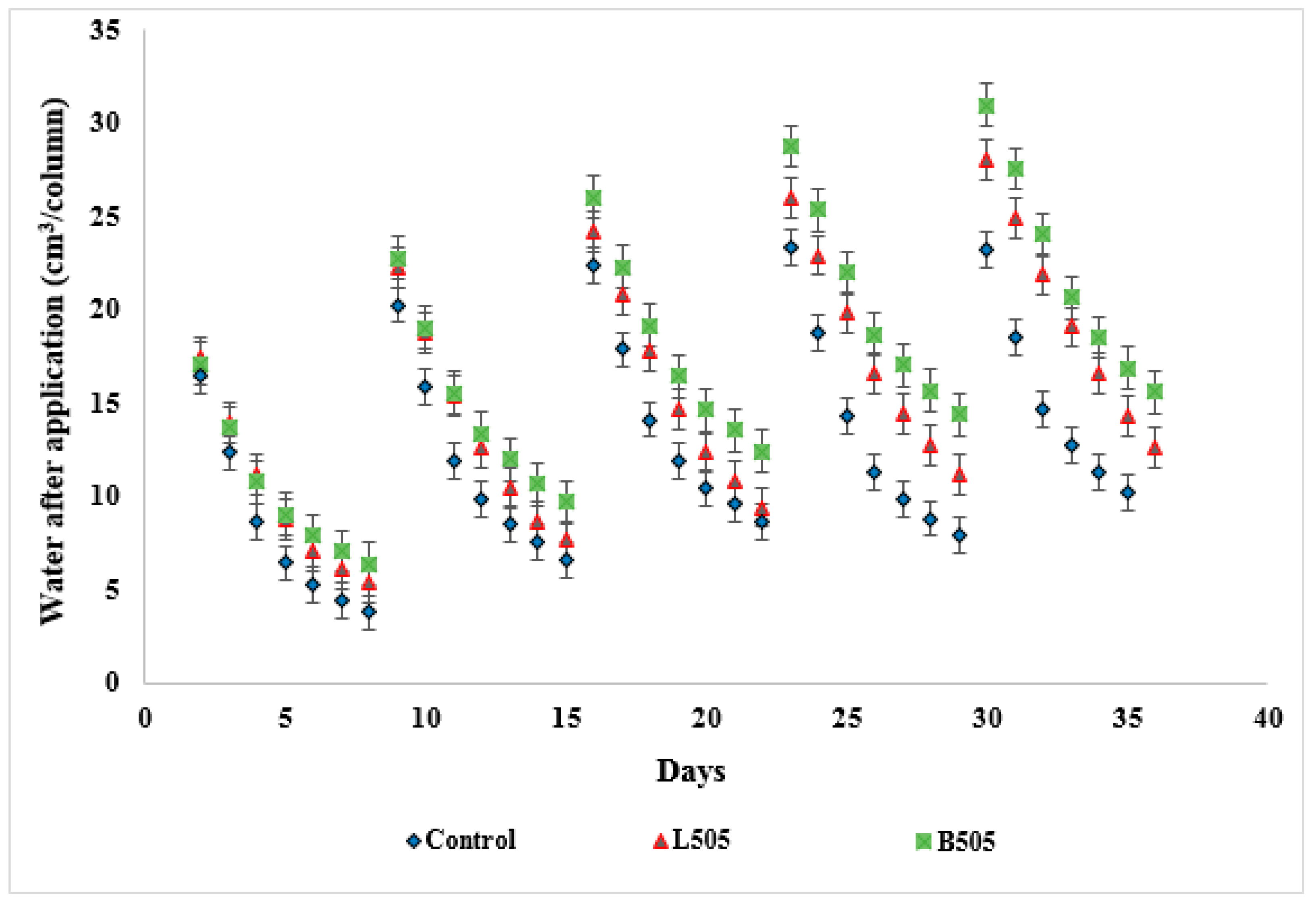
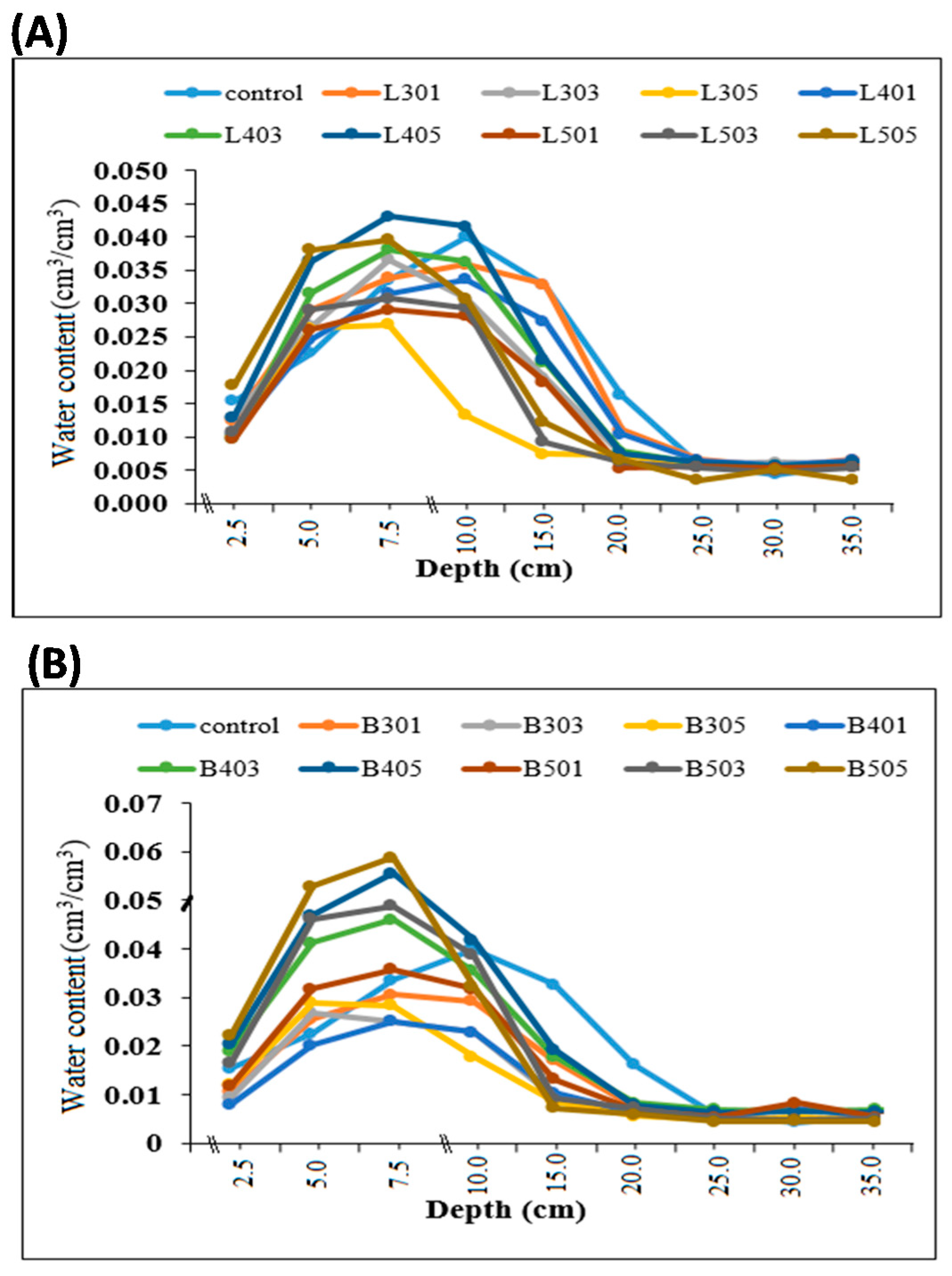
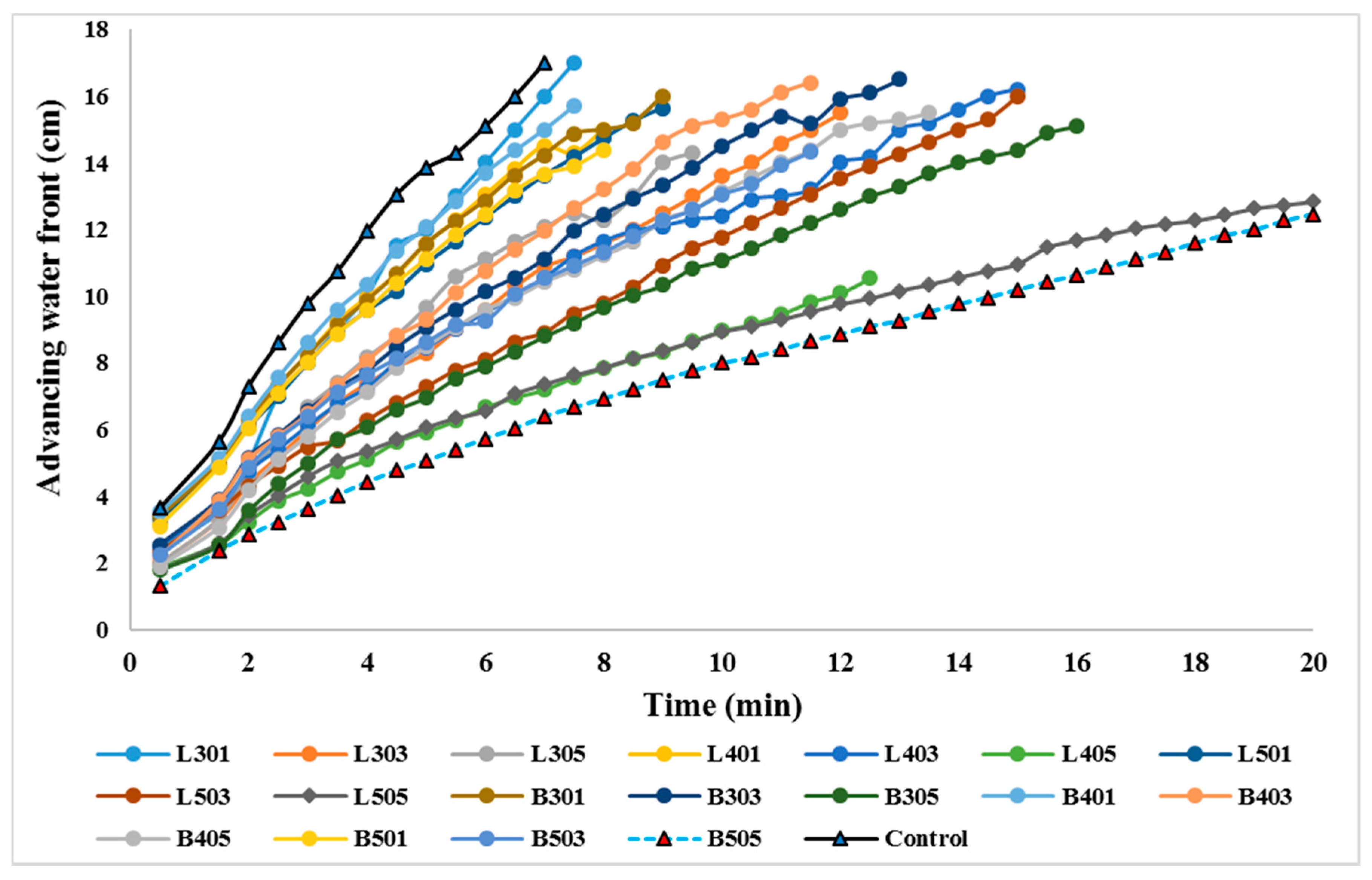
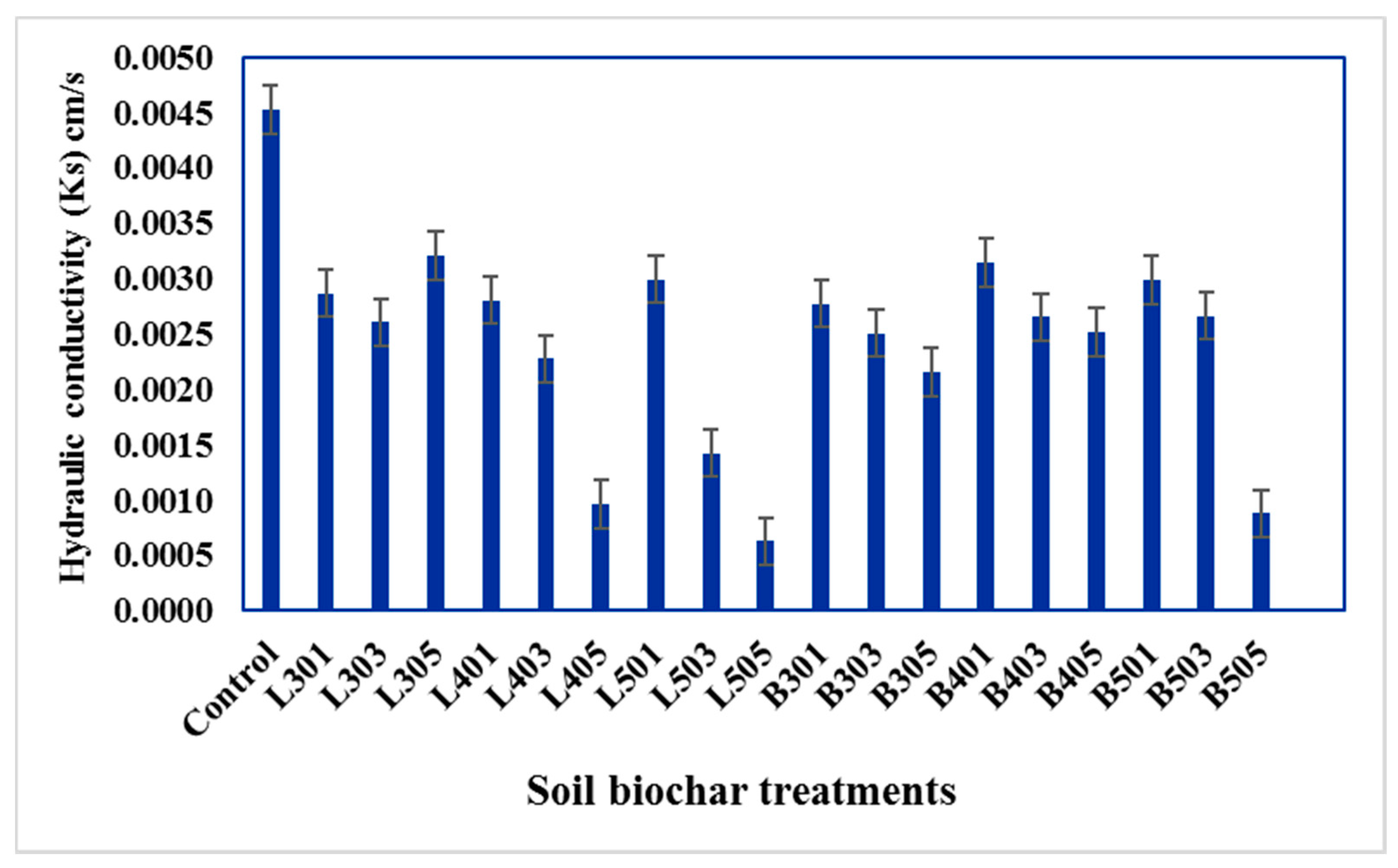
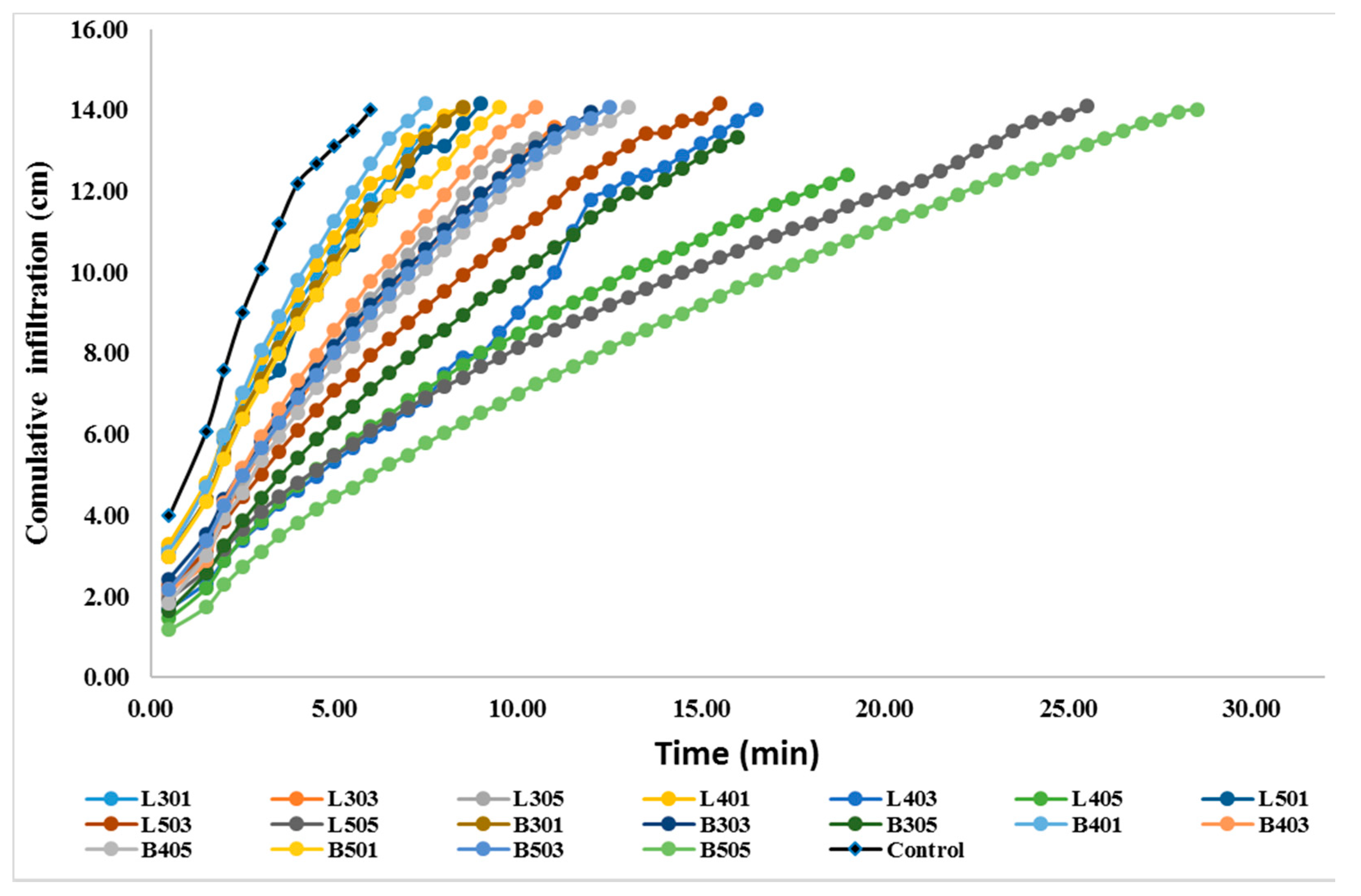
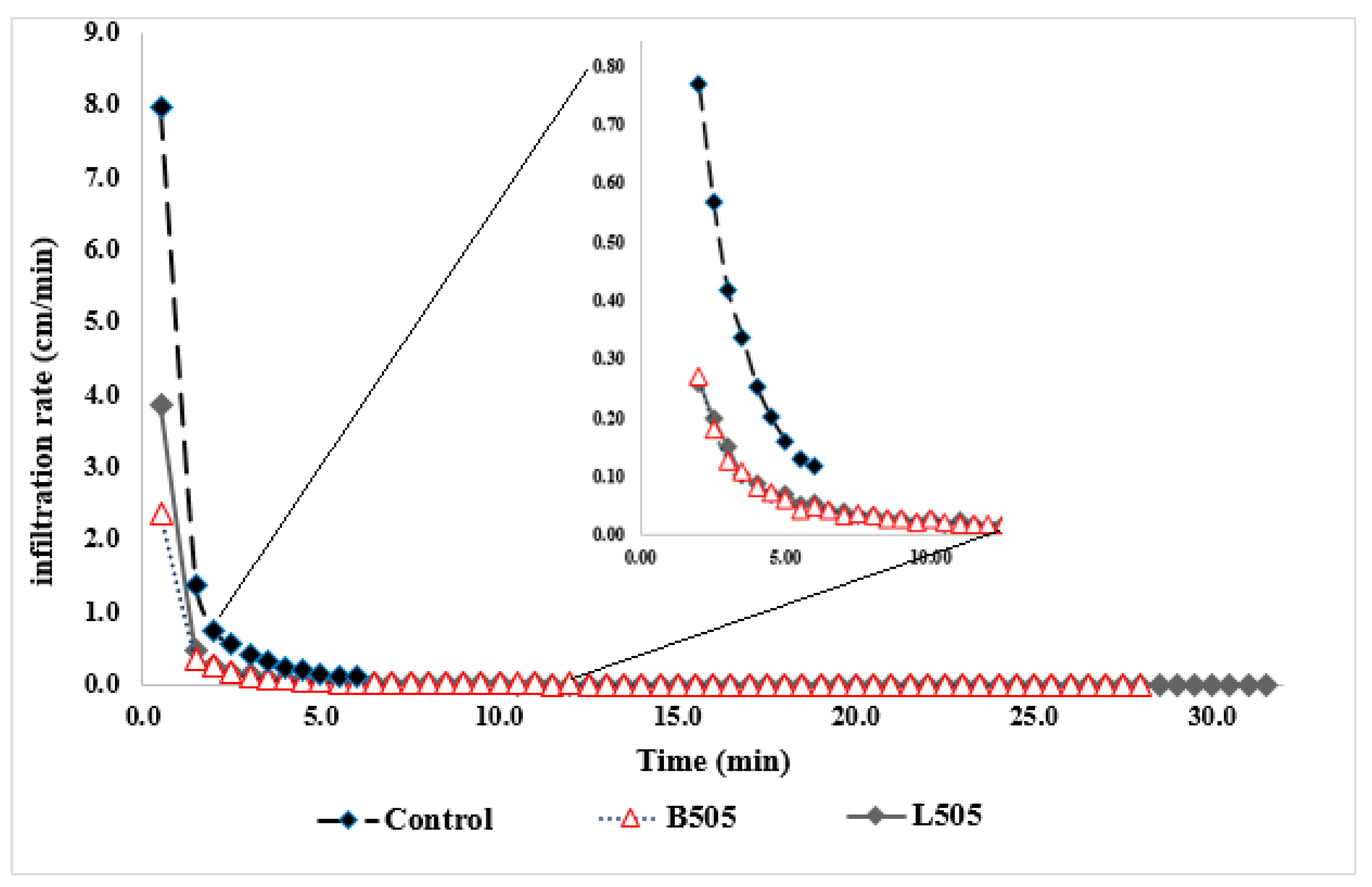
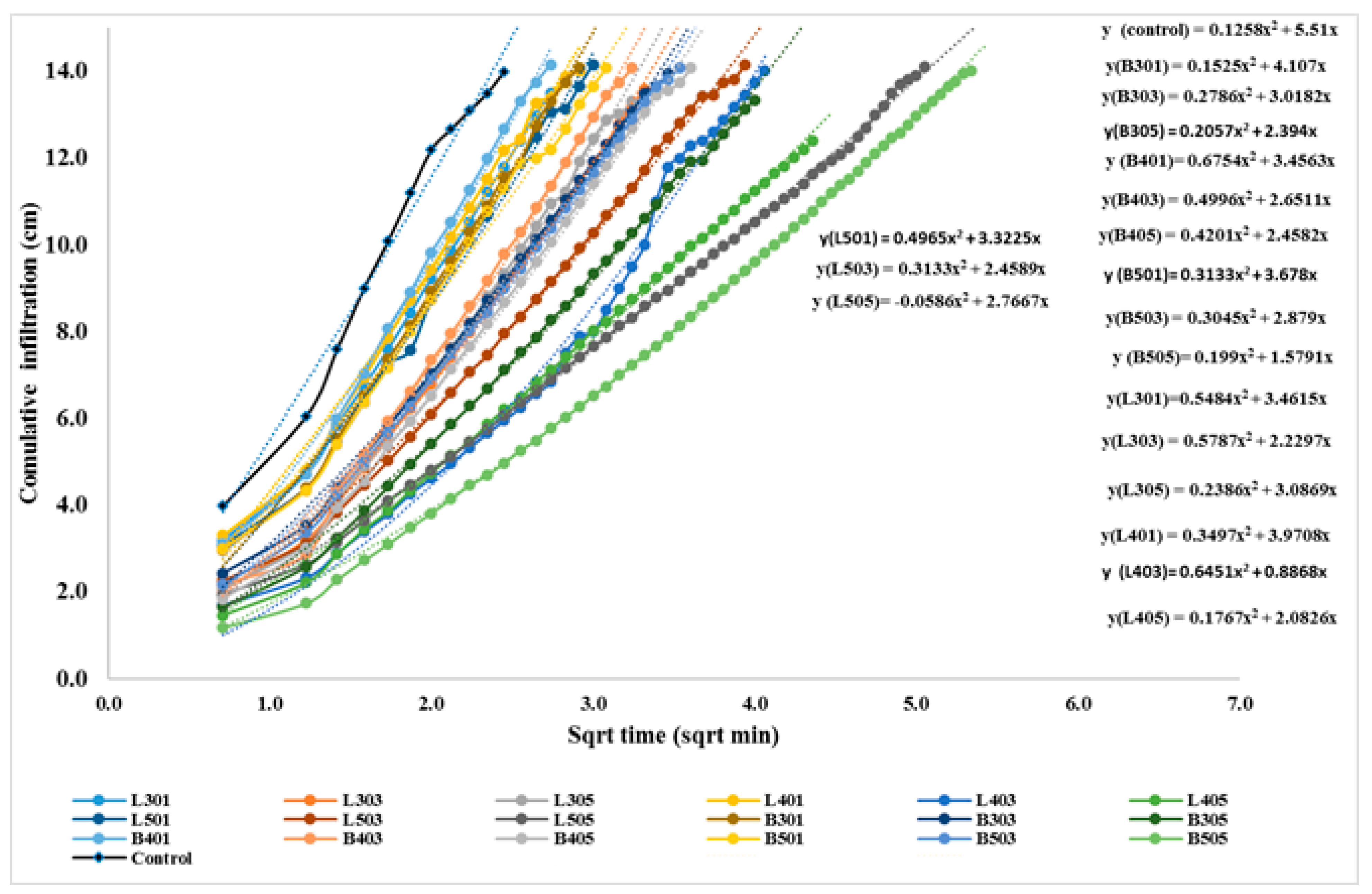
| No. | Key | Feedstock Type | Pyrolysis Temperature | Application Rate | Column Height |
|---|---|---|---|---|---|
| 1 | L301 | Olive leaves | 300 °C | 1% | Top 10 cm |
| 2 | L303 | Olive leaves | 300 °C | 3% | Top 10 cm |
| 3 | L305 | Olive leaves | 300 °C | 5% | Top 10 cm |
| 4 | L401 | Olive leaves | 400 °C | 1% | Top 10 cm |
| 5 | L403 | Olive leaves | 400 °C | 3% | Top 10 cm |
| 6 | L405 | Olive leaves | 400 °C | 5% | Top 10 cm |
| 7 | L501 | Olive leaves | 500 °C | 1% | Top 10 cm |
| 8 | L503 | Olive leaves | 500 °C | 3% | Top 10 cm |
| 9 | L505 | Olive leaves | 500 °C | 5% | Top 10 cm |
| 10 | B301 | Olive branches | 300 °C | 1% | Top 10 cm |
| 11 | B303 | Olive branches | 300 °C | 3% | Top 10 cm |
| 12 | B305 | Olive branches | 300 °C | 5% | Top 10 cm |
| 13 | B401 | Olive branches | 400 °C | 1% | Top 10 cm |
| 14 | B403 | Olive branches | 400 °C | 3% | Top 10 cm |
| 15 | B405 | Olive branches | 400 °C | 5% | Top 10 cm |
| 16 | B501 | Olive branches | 500 °C | 1% | Top 10 cm |
| 17 | B503 | Olive branches | 500 °C | 3% | Top 10 cm |
| 18 | B505 | Olive branches | 500 °C | 5% | Top 10 cm |
| 19 | control | -- | -- | -- | Top 10 cm |
| Sample | Code | pH (1:10) | EC (dSm−1) (1:10) | CEC (cmol kg−1) | Organic Carbon (%) | Total Organic Carbon (%) | Organic Matter (%) |
|---|---|---|---|---|---|---|---|
| 1 | L-300 | 7.87d * | 0.62c | 62.83 | 8.13 | 10.84 | 18.69 |
| 2 | L-400 | 9.67a | 3.85b | 52.39 | 7.03 | 9.38 | 16.17 |
| 3 | L-500 | 9.69a | 5.07a | 47.01 | 5.86 | 7.81 | 13.47 |
| 4 | B-300 | 8.37c | 0.65c | 36.03 | 7.47 | 9.96 | 17.17 |
| 5 | B-400 | 9.17b | 0.49c | 28.35 | 6.45 | 8.60 | 14.83 |
| 6 | B-500 | 9.29b | 0.79c | 27.29 | 5.68 | 7.57 | 13.06 |
| Sample No. | Surface Area (m2/g) | C | H | N | Proximate Analysis (%) | |||
|---|---|---|---|---|---|---|---|---|
| (%) | Moisture | Ash | Volatile Matter | Stable Carbon | ||||
| L300 | 0.3546 ± 0.0138 | 63.8 | 4.85 | 1.28 | 1.39 | 13.82 | 52.30 | 32.49 |
| L400 | 2.1866 ± 0.0422 | 64.79 | 2.72 | 1.62 | 3.56 | 18.11 | 24.54 | 53.79 |
| L500 | 3.9051 ± 0.1168 | 64.88 | 1.37 | 1.21 | 3.23 | 19.96 | 23.61 | 53.20 |
| B300 | 5.0949 ± 0.1676 | 71.8 | 4.33 | ND * | 1.77 | 7.54 | 27.53 | 63.16 |
| B400 | 7.9997 ± 0.2264 | 72.95 | 2.48 | ND | 3.85 | 9.45 | 27.30 | 59.40 |
| B500 | 154.892 ± 3.9804 | 68.14 | 1.40 | ND | 4.64 | 12.1 | 16.31 | 66.99 |
| Treatment | Added Water | Evaporation (mm) | Cumulative Evaporation | Water Retained | Cumulative Evaporation + Water Retained | Recovery % | ||||
|---|---|---|---|---|---|---|---|---|---|---|
| (mm) | Week 1 | Week 2 | Week 3 | Week 4 | Week 5 | (mm) | (mm) | |||
| L301 | 56.1 | 6.0 | 6.3 | 7.0 | 8.3 | 10.1 | 37.7d * | 18.0b | 55.7 | 99.4 |
| L303 | 56.1 | 6.4 | 6.9 | 7.9 | 8.6 | 9.4 | 39.2b | 16.2c | 55.4 | 98.9 |
| L305 | 56.1 | 6.5 | 7.0 | 7.4 | 7.6 | 7.9 | 39.5b | 15.0d | 54.5 | 97.2 |
| L401 | 56.1 | 6.3 | 6.9 | 7.8 | 8.6 | 9.2 | 38.8c | 16.0c | 54.8 | 97.7 |
| L403 | 56.1 | 5.8 | 7.8 | 8.7 | 9.6 | 10.3 | 40.1b | 15.4d | 55.9 | 99.8 |
| L405 | 56.1 | 5.9 | 6.9 | 8.0 | 9.8 | 10.2 | 40.8a | 15.1d | 55.9 | 99.6 |
| L501 | 56.1 | 6.5 | 7.3 | 8.1 | 8.8 | 9.4 | 39.6b | 16.4c | 55.1 | 98.2 |
| L503 | 56.1 | 6.5 | 7.3 | 8.0 | 8.6 | 9.2 | 39.7b | 15.4d | 55.1 | 98.2 |
| L505 | 56.1 | 6.5 | 6.8 | 7.5 | 8.0 | 8.6 | 37.4d | 18.7a | 56.1 | 100.0 |
| B301 | 56.1 | 6.5 | 7.2 | 8.0 | 8.8 | 9.6 | 40.1b | 14.6 e | 54.7 | 97.5 |
| B303 | 56.1 | 6.2 | 7.4 | 8.0 | 8.6 | 9.7 | 39.8b | 15.0 d | 53.8 | 95.9 |
| B305 | 56.1 | 7.2 | 7.4 | 7.9 | 8.3 | 8.7 | 39.6b | 15.3 d | 54.9 | 97.9 |
| B401 | 56.1 | 6.6 | 6.7 | 7.3 | 8.2 | 8.6 | 38.4d | 15.0d | 52.4 | 95.2 |
| B403 | 56.1 | 4.7 | 6.5 | 8.4 | 9.0 | 9.6 | 38.3c | 17.5c | 55.7 | 99.5 |
| B405 | 56.1 | 5.7 | 6.4 | 7.1 | 7.5 | 9.1 | 36.8e | 18.8a | 55.7 | 99.5 |
| B501 | 56.1 | 6.3 | 6.8 | 7.4 | 7.8 | 9.4 | 37.8d | 16.1c | 53.9 | 96.1 |
| B503 | 56.1 | 6.5 | 7.1 | 7.8 | 8.2 | 8.8 | 38.4c | 17.1c | 55.5 | 98.9 |
| B505 | 56.1 | 6.5 | 6.8 | 7.5 | 8.0 | 8.4 | 37.3d | 18.7a | 57.5 | 99.8 |
| Control | 56.1 | 6.2 | 8.0 | 8.8 | 8.8 | 9.1 | 40.9a | 14.5e | 55.4 | 98.8 |
| Ψ (Bar) Treatments | −0.1 | −0.3 | −1 | −1.5 | −3 | −5 | −10 | −15 |
|---|---|---|---|---|---|---|---|---|
| Soil Water Content (cm3 cm−3) | ||||||||
| Control | 0.135 | 0.075 | 0.047 | 0.038 | 0.038 | 0.038 | 0.037 | 0.030 |
| L301 | 0.145 | 0.085 | 0.057 | 0.052 | 0.049 | 0.047 | 0.046 | 0.040 |
| L305 | 0.239 | 0.145 | 0.087 | 0.074 | 0.061 | 0.054 | 0.047 | 0.045 |
| L501 | 0.155 | 0.095 | 0.067 | 0.062 | 0.059 | 0.057 | 0.056 | 0.050 |
| L505 | 0.230 | 0.159 | 0.080 | 0.067 | 0.068 | 0.052 | 0.050 | 0.046 |
| B301 | 0.170 | 0.109 | 0.082 | 0.076 | 0.073 | 0.071 | 0.067 | 0.064 |
| B305 | 0.210 | 0.153 | 0.078 | 0.075 | 0.063 | 0.059 | 0.046 | 0.044 |
| B501 | 0.159 | 0.106 | 0.061 | 0.059 | 0.051 | 0.044 | 0.035 | 0.033 |
| B505 | 0.222 | 0.166 | 0.094 | 0.094 | 0.079 | 0.072 | 0.068 | 0.052 |
| St. deviation | 0.04 | 0.03 | 0.02 | 0.02 | 0.01 | 0.01 | 0.01 | 0.01 |
| Standard error | 0.15 | 0.14 | 0.12 | 0.12 | 0.11 | 0.11 | 0.11 | 0.11 |
| Skew | 0.19 | 0.05 | −0.35 | −0.11 | −0.28 | 0.28 | 0.46 | 0.36 |
| Ψ (Bar) | Soil Water Content (cm cm−3) | ||||||||
|---|---|---|---|---|---|---|---|---|---|
| Control | L301 | L305 | L501 | L505 | B301 | B305 | B501 | B505 | |
| −0.3 (FC) 1 | 0.075 | 0.085 | 0.145 | 0.095 | 0.159 | 0.109 | 0.153 | 0.106 | 0.166 |
| −15 (PWP) 2 | 0.030 | 0.040 | 0.045 | 0.050 | 0.046 | 0.064 | 0.044 | 0.033 | 0.052 |
| AW 3 | 0.045c 4 | 0.045c | 0.105a | 0.045c | 0.113a | 0.045c | 0.109a | 0.073b | 0.114a |
| Sorptivity 5 (cm min−0.5) | 5.51 | 3.46 | 3.09 | 3.32 | 2.77 | 4.11 | 2.39 | 3.68 | 1.58 |
Publisher’s Note: MDPI stays neutral with regard to jurisdictional claims in published maps and institutional affiliations. |
© 2021 by the authors. Licensee MDPI, Basel, Switzerland. This article is an open access article distributed under the terms and conditions of the Creative Commons Attribution (CC BY) license (https://creativecommons.org/licenses/by/4.0/).
Share and Cite
Alghamdi, A.G.; Aljohani, B.H.; Aly, A.A. Impacts of Olive Waste-Derived Biochar on Hydro-Physical Properties of Sandy Soil. Sustainability 2021, 13, 5493. https://doi.org/10.3390/su13105493
Alghamdi AG, Aljohani BH, Aly AA. Impacts of Olive Waste-Derived Biochar on Hydro-Physical Properties of Sandy Soil. Sustainability. 2021; 13(10):5493. https://doi.org/10.3390/su13105493
Chicago/Turabian StyleAlghamdi, Abdulaziz G., Bandar H. Aljohani, and Anwar A. Aly. 2021. "Impacts of Olive Waste-Derived Biochar on Hydro-Physical Properties of Sandy Soil" Sustainability 13, no. 10: 5493. https://doi.org/10.3390/su13105493
APA StyleAlghamdi, A. G., Aljohani, B. H., & Aly, A. A. (2021). Impacts of Olive Waste-Derived Biochar on Hydro-Physical Properties of Sandy Soil. Sustainability, 13(10), 5493. https://doi.org/10.3390/su13105493






